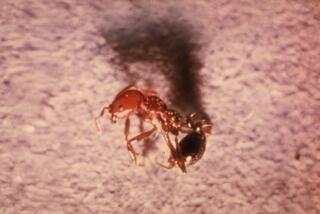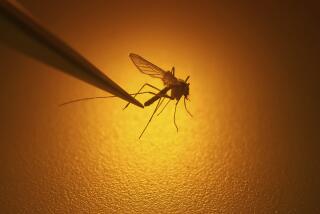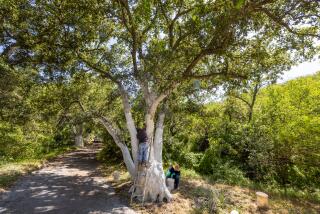Colony of ‘Super Termites’ Discovered in La Mesa Home
A colony of Formosan termites has been discovered at a La Mesa home, the first major infestation of the feared “super termite” in California.
“It’s here,” said Dr. Michael Rust, a professor of entomology at UC Riverside. “Now the question is: How extensive is it? and is it able to find other micro-niches in the environment? I think it’s too early to pass it off.”
The colony of highly aggressive termites was discovered by a professional exterminator. When treatment failed to halt the insects a year ago, the homeowner called the firm under a warranty that guaranteed extermination.
The exterminator brought in a representative from the pesticide supplier, who agreed that the termites were unusual. They took samples to Rust, and he and a colleague visited the house and confirmed the infestation.
The discovery was trumpeted Wednesday by the Pest Control Operators of California. Last year, the group held a news conference to urge Californians to watch for the Formosan termite, only to have state agricultural officials say their concern was overblown.
State officials still maintain that the climate is too arid to allow the spread of the pest, which is much more destructive than native subterranean termites.
“Our information is that it is a tropical termite, and that California’s arid climate is not suited to it, unless they find a niche,” said Gera Curry, spokeswoman for the state Department of Food and Agriculture.
Curry said Formosan termites are found at the rate of about one every other year on ships docking in California.
San Diego County’s supervising entomologist, Dr. David Kellum, said there is no urgency because termites move slowly.
Kellum said the colony could be a decade or more old. He said the residence is in a well-watered and heavily wooded area, so the discovery does not conflict with the view that Formosan termites are seldom found in arid areas.
Formosan termites, which originated in China, have harder mandibles than other kinds of termites and are capable of tearing through soft metal in their pursuit of wood, entomologists say.
Their colonies also run to the tens of millions, contrasted with subterranean termites, whose colonies are in the hundreds of thousands.
More to Read
Sign up for Essential California
The most important California stories and recommendations in your inbox every morning.
You may occasionally receive promotional content from the Los Angeles Times.










